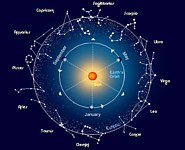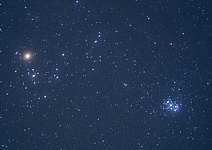4) Some star regions appear increasingly "delayed" in relation to sunset, and new ones appear increasingly "advanced".
 To notice this phenomenon, an observer must record the night sky for at least a year, since in that time all the possible constellations for a geographic region will have appeared. The determining factor is that, once the observer has identified and invented his own asterisms of bright stars, at some point he will realize that they appear closer and closer to sunset, to the point of being difficult to observe due to the obscuring sunshine. In the same way, it is discovered that other groups of stars, which previously did not appear during the night, are now emerging further ahead of dawn, to the point of being visible for longer during the night, as much as the first asterisms were before. identified.
To notice this phenomenon, an observer must record the night sky for at least a year, since in that time all the possible constellations for a geographic region will have appeared. The determining factor is that, once the observer has identified and invented his own asterisms of bright stars, at some point he will realize that they appear closer and closer to sunset, to the point of being difficult to observe due to the obscuring sunshine. In the same way, it is discovered that other groups of stars, which previously did not appear during the night, are now emerging further ahead of dawn, to the point of being visible for longer during the night, as much as the first asterisms were before. identified.
Preliminary conclusion: Discovery of the movement of constellations during the year. By observing the night sky for a full year, and paying attention to the different groups of "fixed stars", it is possible to observe that these groups vary over the months. These fixed stars actually move around, showing new groupings and making others "disappear", which in reality end up being blocked by sunlight. If the monitoring is extended to 2, 3 or more years, it becomes clear that this "renewal of constellations" simply follows a cycle that repeats itself after 12 months.
5) Based on the above, I can use specific objects (e.g. Pleiades) to establish cycles and section time according to the moment of their appearance.
 The invention of figures and patterns in the stars according to their luminosity can lead to giving them names or personalities according to some mythological figure typical of a culture. Simulating an observer who does the same, he can establish that any group of stars (e.g. the now known Pleiades cluster) is his guide to section time, once he knows that this group of stars reappears in a point on the sky after a certain time (thus, this experiment requires at least 1 year of observation). Knowing the time it takes for that group of stars (e.g. Pleiades) to reappear in the same position (e.g. above a mountain), added to the knowledge of days, lunar phases or other temporal guides, an observer can sectioning time into longer spaces, either for everyday life purposes (e.g. harvest time) or astronomical purposes (e.g. knowing that when the Pleiades appear lower on the horizon, another group of known stars is about to appear) .
The invention of figures and patterns in the stars according to their luminosity can lead to giving them names or personalities according to some mythological figure typical of a culture. Simulating an observer who does the same, he can establish that any group of stars (e.g. the now known Pleiades cluster) is his guide to section time, once he knows that this group of stars reappears in a point on the sky after a certain time (thus, this experiment requires at least 1 year of observation). Knowing the time it takes for that group of stars (e.g. Pleiades) to reappear in the same position (e.g. above a mountain), added to the knowledge of days, lunar phases or other temporal guides, an observer can sectioning time into longer spaces, either for everyday life purposes (e.g. harvest time) or astronomical purposes (e.g. knowing that when the Pleiades appear lower on the horizon, another group of known stars is about to appear) .
Preliminary conclusion: Using constellations to measure time. Constellations have not only served as a guide in time, but also as a time-segmenting tool. Once the "renewal" of constellations during a year is known with precision, it is only necessary to make a few calculations to predict when a particular group of stars will appear again, and in the same way, to associate this prediction with some important event in the daily life of the observer who is guided by the stars.

